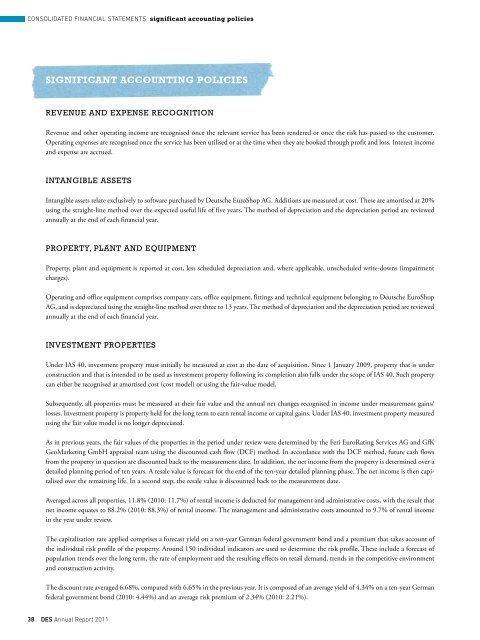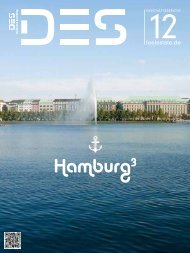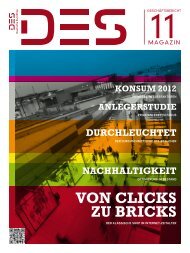Financials - Deutsche EuroShop
Financials - Deutsche EuroShop
Financials - Deutsche EuroShop
Create successful ePaper yourself
Turn your PDF publications into a flip-book with our unique Google optimized e-Paper software.
ConSoLIDAteD FInAnCIAL StAteMentS significant accounting policies<br />
signifiCant aCCounting poliCies<br />
REvENuE aND ExpENSE RECOGNITION<br />
Revenue and other operating income are recognised once the relevant service has been rendered or once the risk has passed to the customer.<br />
Operating expenses are recognised once the service has been utilised or at the time when they are booked through profit and loss. Interest income<br />
and expense are accrued.<br />
INTaNGIBlE aSSETS<br />
Intangible assets relate exclusively to software purchased by <strong>Deutsche</strong> <strong>EuroShop</strong> AG. Additions are measured at cost. These are amortised at 20%<br />
using the straight-line method over the expected useful life of five years. The method of depreciation and the depreciation period are reviewed<br />
annually at the end of each financial year.<br />
pROpERTY, plaNT aND EquIpMENT<br />
Property, plant and equipment is reported at cost, less scheduled depreciation and, where applicable, unscheduled write-downs (impairment<br />
charges).<br />
Operating and office equipment comprises company cars, office equipment, fittings and technical equipment belonging to <strong>Deutsche</strong> <strong>EuroShop</strong><br />
AG, and is depreciated using the straight-line method over three to 13 years. The method of depreciation and the depreciation period are reviewed<br />
annually at the end of each financial year.<br />
INvESTMENT pROpERTIES<br />
Under IAS 40, investment property must initially be measured at cost at the date of acquisition. Since 1 January 2009, property that is under<br />
construction and that is intended to be used as investment property following its completion also falls under the scope of IAS 40. Such property<br />
can either be recognised at amortised cost (cost model) or using the fair-value model.<br />
Subsequently, all properties must be measured at their fair value and the annual net changes recognised in income under measurement gains/<br />
losses. Investment property is property held for the long term to earn rental income or capital gains. Under IAS 40, investment property measured<br />
using the fair value model is no longer depreciated.<br />
As in previous years, the fair values of the properties in the period under review were determined by the Feri EuroRating Services AG and GfK<br />
GeoMarketing GmbH appraisal team using the discounted cash flow (DCF) method. In accordance with the DCF method, future cash flows<br />
from the property in question are discounted back to the measurement date. In addition, the net income from the property is determined over a<br />
detailed planning period of ten years. A resale value is forecast for the end of the ten-year detailed planning phase. The net income is then capitalised<br />
over the remaining life. In a second step, the resale value is discounted back to the measurement date.<br />
Averaged across all properties, 11.8% (2010: 11.7%) of rental income is deducted for management and administrative costs, with the result that<br />
net income equates to 88.2% (2010: 88.3%) of rental income. The management and administrative costs amounted to 9.7% of rental income<br />
in the year under review.<br />
The capitalisation rate applied comprises a forecast yield on a ten-year German federal government bond and a premium that takes account of<br />
the individual risk profile of the property. Around 150 individual indicators are used to determine the risk profile. These include a forecast of<br />
population trends over the long term, the rate of employment and the resulting effects on retail demand, trends in the competitive environment<br />
and construction activity.<br />
The discount rate averaged 6.68%, compared with 6.65% in the previous year. It is composed of an average yield of 4.34% on a ten-year German<br />
federal government bond (2010: 4.44%) and an average risk premium of 2.34% (2010: 2.21%).<br />
38 Des Annual Report 2011





